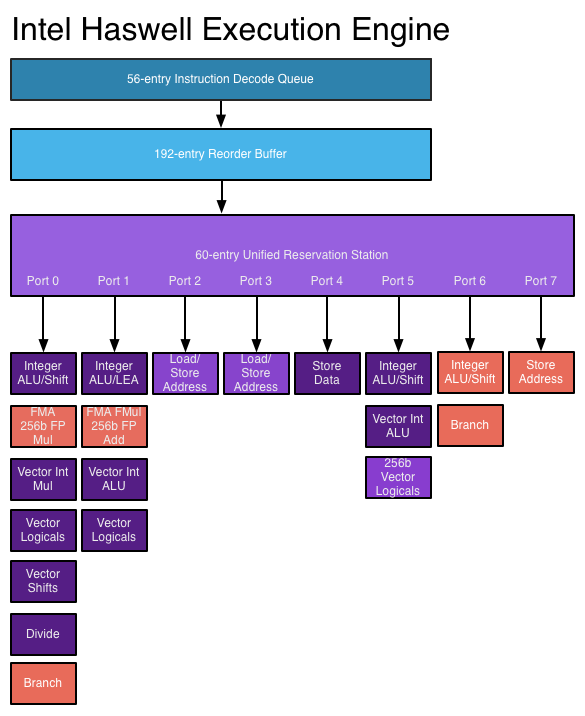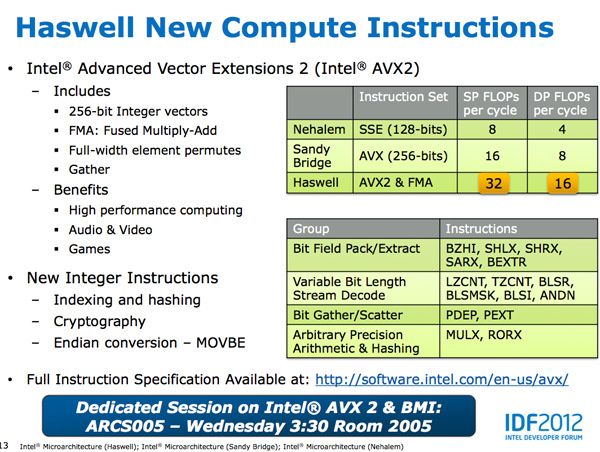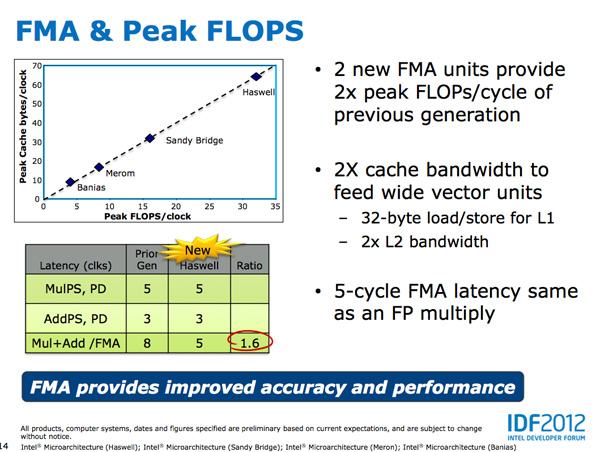Intel's Haswell Architecture Analyzed: Building a New PC and a New Intel
by Anand Lal Shimpi on October 5, 2012 2:45 AM ESTHaswell's Wide Execution Engine
Conroe introduced the six execution ports that we've seen used all the way up to Ivy Bridge. Sandy Bridge saw significant changes to the execution engine to enable 256-bit AVX operations but without increasing the back end width. Haswell does a lot here.
Just as before, I put together a few diagrams that highlight the major differences throughout the past three generations for the execution engine.

The reorder buffer is one giant tracking structure for all of the micro-ops that are in various stages of execution. The size of this buffer is directly impacted by the accuracy of the branch predictor as that will determine how many instructions can be kept in flight at a given time.
The reservation station holds micro-ops as they wait for the data they need to begin execution. Both of these structures grow by low double-digit percentages in Haswell.
Simply being able to pick from more instructions to execute in parallel is one thing, we haven't seen an increase in the number of parallel execution ports since Conroe. Haswell changes that.
From Conroe to Ivy Bridge, Intel's Core micro-architecture has supported the execution of up to six micro-ops in parallel. While there are more than six execution units in the system, there are only six ports to stacks of execution units. Three ports are used for memory operations (loads/stores) while three are on math duty. Over the years Intel has added additional types and widths of execution units (e.g. Sandy Bridge added 256-bit AVX operations) but it hasn't strayed from the 6 port architecture.
Haswell finally adds two more execution ports, one for integer math and branches (port 6) and one for store address calculation (port 7). Including both additional compute and memory hardware is a balanced decision on Intel's part.
The extra ALU and port does one of two things: either improve performance for integer heavy code, or allow integer work to continue while FP math occupies ports 0 and 1. Remember that Haswell, like its predecessors, is an SMT design meaning each core will see instructions from up to two threads at the same time. Although a single app is unlikely to mix heavy vector FP and integer code, it's quite possible that two applications running at the same time may produce such varied instructions. Having more integer ALUs is never a bad thing.
Also using port 6 is another unit that can handle x86 branch instructions. Branch heavy code can now enjoy two independent branch units, or if port 0 is occupied with other math the machine can still execute branches on port 6. Haswell moved the original Core branch unit from port 5 over to port 0, the most capable port in the system, so a branch unit on a lightly populated port makes helps ensure there's no performance regression as a result of the change.
Sandy Bridge made ports 2 & 3 equal class citizens, with both capable of being used for load or store address calculation. In the past you could only do loads on port 2 and store addresses on port 3. Sandy Bridge's flexibility did a lot for load heavy code, which is quite common. Haswell's dedicated store address port should help in mixed workloads with lots of loads and stores.
The other major addition to the execution engine is support for Intel's AVX2 instructions, including FMA (Fused Multiply-Add). Ports 0 & 1 now include newly designed 256-bit FMA units. As each FMA operation is effectively two floating point operations, these two units double the peak floating point throughput of Haswell compared to Sandy/Ivy Bridge. A side effect of the FMA units is that you now get two ports worth of FP multiply units, which can be a big boon to legacy FP code.
Fused Multiply-Add operations are incredibly handy in all sorts of media processing and 3D work. Rather than having to independently multiply and add values, being able to execute both in tandem via a single execution port increases the effective execution width of the machine. Note that a single FMA operation takes 5 cycles in Haswell, which is the same latency as a FP multiply from Sandy/Ivy Bridge. In the previous generation a floating point multiply+add took 8 cycles, so there's a good latency improvement here as well as the throughput boost from having two FMA units.

Intel focused a lot on adding more execution horsepower in Haswell without creating a power burden for legacy use cases. All of the new units can be shut off when not in use. Furthermore, Intel went in and ensured that this applied to the older execution units as well: in Haswell if you're not doing work, you're not consuming power.












245 Comments
View All Comments
Spunjji - Thursday, October 18, 2012 - link
Fuckwit.nirmalv - Sunday, October 7, 2012 - link
Anandtech being a hardware site,its more inclined to keenly flow hardware devices with new architecture and innovations. iphone brings in1, A new A7 chip design and a novel 3 core graphics core
2, A new 3 microphone parabolic sound receiving design(which likely will become the new standard)
3, A new sim tray design(which will also likely become the new standard)
4, New sony BSI stacked sensor (the 13 mpx version will likely be the rage next year).
5, The first time that we have a 32 nm LTE chip which will give all day usage.
6, New thinner screen with incorporated touch panel and 100 % RGB
I am not sure about samsung but can anyone enlighten me about S3's technical achievements?
nirmalv - Sunday, October 7, 2012 - link
Sorry make that a 28 nm LTE basebandcenthar - Sunday, October 7, 2012 - link
99.998% of iPhone users just don't care about that. Really they don't.Geeks like me who do, are too damn smart to sell our souls to the such a god damned, locked down and closed system to even bother to care.
Magik_Breezy - Sunday, October 14, 2012 - link
2nd thatSpunjji - Thursday, October 18, 2012 - link
3rdCaptainDoug - Tuesday, October 23, 2012 - link
4th,solipsism - Tuesday, October 9, 2012 - link
Of course a company that releases one device per product category per year as well as one with the greatest mindshare is going to have more articles.But what happens when you add up all Samsung phones against all Apple phones in a given year?
What happens when you don't count the small blogs that only detail a small aspect of a secretive product but count the total words to get a better feel for the effort spent per company's market segment?
I bet you'll find that AT spends a lot more time covering Samsung's phones than Apple's.
Spunjji - Thursday, October 18, 2012 - link
This. I generally trust their editorial, but the focus on Apple prevails. One just has to read accordingly.Kepe - Friday, October 5, 2012 - link
Also look at any other Apple product review. They are all ridiculously in-depth with analysis about almost every single component in the product. Macbook Pro with Retina Display got 18 pages, the 3rd gen iPad got 21 pages. Don't get me wrong, I like a proper review with everything analyzed, but it's only the Apple products that get these huge reviews. But compared to those massive Apple reviews, it's like all other products are just glanced over in a hurry. The new Razer Blade got 9 pages. Asus Transformer Pad Infinity got 8 pages.